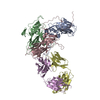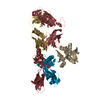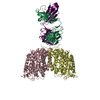Entry Database : PDB / ID : 3wsqTitle Structure of HER2 with an Fab Antibody Heavy Chain Antibody Light Chain Receptor tyrosine-protein kinase erbB-2 Keywords / / Function / homology Function Domain/homology Component
/ / / / / / / / / / / / / / / / / / / / / / / / / / / / / / / / / / / / / / / / / / / / / / / / / / / / / / / / / / / / / / / / / / / / / / / / / / / / / / / / / / / / / / / / / / / / / / / / / / / / / / / / / / / / / / / / / / / / / / / / / / / / / / / / / / / / / / / / / / / / / / / / / / / / / / / Biological species Homo sapiens (human)Method / / / Resolution : 3.5 Å Authors Fu, W.Y. / Wang, Y.X. / Zhou, L.J. Journal : MAbs / Year : 2014Title : Insights into HER2 signaling from step-by-step optimization of anti-HER2 antibodies.Authors : Fu, W. / Wang, Y. / Zhang, Y. / Xiong, L. / Takeda, H. / Ding, L. / Xu, Q. / He, L. / Tan, W. / Bethune, A.N. / Zhou, L. History Deposition Mar 20, 2014 Deposition site / Processing site Revision 1.0 Mar 25, 2015 Provider / Type Revision 1.1 Nov 22, 2017 Group / Category / Item
Show all Show less
 Open data
Open data Basic information
Basic information Components
Components Keywords
Keywords Kinase / TRANSFERASE-IMMUNE SYSTEM complex
Kinase / TRANSFERASE-IMMUNE SYSTEM complex Function and homology information
Function and homology information Drug resistance in ERBB2 TMD/JMD mutants /
Drug resistance in ERBB2 TMD/JMD mutants /  enzyme-linked receptor protein signaling pathway / positive regulation of transcription by RNA polymerase I / ERBB2-ERBB3 signaling pathway / oligodendrocyte differentiation / ERBB2 Regulates Cell Motility / semaphorin-plexin signaling pathway / PI3K events in ERBB2 signaling / positive regulation of protein targeting to membrane / positive regulation of cell adhesion /
enzyme-linked receptor protein signaling pathway / positive regulation of transcription by RNA polymerase I / ERBB2-ERBB3 signaling pathway / oligodendrocyte differentiation / ERBB2 Regulates Cell Motility / semaphorin-plexin signaling pathway / PI3K events in ERBB2 signaling / positive regulation of protein targeting to membrane / positive regulation of cell adhesion /  regulation of angiogenesis /
regulation of angiogenesis /  coreceptor activity / Schwann cell development / Signaling by ERBB2 / cellular response to epidermal growth factor stimulus /
coreceptor activity / Schwann cell development / Signaling by ERBB2 / cellular response to epidermal growth factor stimulus /  myelination / Downregulation of ERBB2:ERBB3 signaling / TFAP2 (AP-2) family regulates transcription of growth factors and their receptors / GRB2 events in ERBB2 signaling /
myelination / Downregulation of ERBB2:ERBB3 signaling / TFAP2 (AP-2) family regulates transcription of growth factors and their receptors / GRB2 events in ERBB2 signaling /  neurogenesis /
neurogenesis /  transmembrane receptor protein tyrosine kinase activity / SHC1 events in ERBB2 signaling / Constitutive Signaling by Overexpressed ERBB2 / basal plasma membrane / regulation of ERK1 and ERK2 cascade / positive regulation of translation / phosphatidylinositol 3-kinase/protein kinase B signal transduction / positive regulation of epithelial cell proliferation / Signaling by ERBB2 TMD/JMD mutants /
transmembrane receptor protein tyrosine kinase activity / SHC1 events in ERBB2 signaling / Constitutive Signaling by Overexpressed ERBB2 / basal plasma membrane / regulation of ERK1 and ERK2 cascade / positive regulation of translation / phosphatidylinositol 3-kinase/protein kinase B signal transduction / positive regulation of epithelial cell proliferation / Signaling by ERBB2 TMD/JMD mutants /  neuromuscular junction / positive regulation of MAP kinase activity /
neuromuscular junction / positive regulation of MAP kinase activity /  wound healing / Signaling by ERBB2 ECD mutants / Signaling by ERBB2 KD Mutants /
wound healing / Signaling by ERBB2 ECD mutants / Signaling by ERBB2 KD Mutants /  receptor tyrosine kinase binding /
receptor tyrosine kinase binding /  receptor protein-tyrosine kinase / neuron differentiation / cellular response to growth factor stimulus / ruffle membrane / Downregulation of ERBB2 signaling / peptidyl-tyrosine phosphorylation /
receptor protein-tyrosine kinase / neuron differentiation / cellular response to growth factor stimulus / ruffle membrane / Downregulation of ERBB2 signaling / peptidyl-tyrosine phosphorylation /  cell surface receptor protein tyrosine kinase signaling pathway / Constitutive Signaling by Aberrant PI3K in Cancer / transmembrane signaling receptor activity / PIP3 activates AKT signaling /
cell surface receptor protein tyrosine kinase signaling pathway / Constitutive Signaling by Aberrant PI3K in Cancer / transmembrane signaling receptor activity / PIP3 activates AKT signaling /  presynaptic membrane /
presynaptic membrane /  myelin sheath /
myelin sheath /  heart development / PI5P, PP2A and IER3 Regulate PI3K/AKT Signaling / RAF/MAP kinase cascade / positive regulation of cell growth / basolateral plasma membrane /
heart development / PI5P, PP2A and IER3 Regulate PI3K/AKT Signaling / RAF/MAP kinase cascade / positive regulation of cell growth / basolateral plasma membrane /  protein tyrosine kinase activity / positive regulation of MAPK cascade / cell surface receptor signaling pathway /
protein tyrosine kinase activity / positive regulation of MAPK cascade / cell surface receptor signaling pathway /  early endosome /
early endosome /  receptor complex / endosome membrane / intracellular signal transduction / positive regulation of protein phosphorylation / apical plasma membrane / protein heterodimerization activity /
receptor complex / endosome membrane / intracellular signal transduction / positive regulation of protein phosphorylation / apical plasma membrane / protein heterodimerization activity /  signaling receptor binding /
signaling receptor binding /  protein phosphorylation / positive regulation of cell population proliferation / negative regulation of apoptotic process / perinuclear region of cytoplasm /
protein phosphorylation / positive regulation of cell population proliferation / negative regulation of apoptotic process / perinuclear region of cytoplasm /  signal transduction /
signal transduction /  nucleoplasm /
nucleoplasm /  ATP binding /
ATP binding /  membrane / identical protein binding /
membrane / identical protein binding /  nucleus /
nucleus /  plasma membrane
plasma membrane
 Homo sapiens (human)
Homo sapiens (human) X-RAY DIFFRACTION /
X-RAY DIFFRACTION /  SYNCHROTRON /
SYNCHROTRON /  MOLECULAR REPLACEMENT / Resolution: 3.5 Å
MOLECULAR REPLACEMENT / Resolution: 3.5 Å  Authors
Authors Citation
Citation Journal: MAbs / Year: 2014
Journal: MAbs / Year: 2014 Structure visualization
Structure visualization Molmil
Molmil Jmol/JSmol
Jmol/JSmol Downloads & links
Downloads & links Download
Download 3wsq.cif.gz
3wsq.cif.gz PDBx/mmCIF format
PDBx/mmCIF format pdb3wsq.ent.gz
pdb3wsq.ent.gz PDB format
PDB format 3wsq.json.gz
3wsq.json.gz PDBx/mmJSON format
PDBx/mmJSON format Other downloads
Other downloads https://data.pdbj.org/pub/pdb/validation_reports/ws/3wsq
https://data.pdbj.org/pub/pdb/validation_reports/ws/3wsq ftp://data.pdbj.org/pub/pdb/validation_reports/ws/3wsq
ftp://data.pdbj.org/pub/pdb/validation_reports/ws/3wsq Links
Links Assembly
Assembly
 Components
Components
 Homo sapiens (human) / Gene: ERBB2 / Plasmid: plasmid / Production host:
Homo sapiens (human) / Gene: ERBB2 / Plasmid: plasmid / Production host: 
 Cricetulus griseus (Chinese hamster)
Cricetulus griseus (Chinese hamster) receptor protein-tyrosine kinase
receptor protein-tyrosine kinase Immunoglobulin light chain
Immunoglobulin light chain
 Homo sapiens (human) / Plasmid: plasmid / Production host:
Homo sapiens (human) / Plasmid: plasmid / Production host: 
 Cricetulus griseus (Chinese hamster)
Cricetulus griseus (Chinese hamster) Immunoglobulin heavy chain
Immunoglobulin heavy chain
 Homo sapiens (human) / Plasmid: plasmid / Production host:
Homo sapiens (human) / Plasmid: plasmid / Production host: 
 Cricetulus griseus (Chinese hamster)
Cricetulus griseus (Chinese hamster) X-RAY DIFFRACTION / Number of used crystals: 1
X-RAY DIFFRACTION / Number of used crystals: 1  Sample preparation
Sample preparation
 SYNCHROTRON / Site:
SYNCHROTRON / Site:  Photon Factory
Photon Factory  / Beamline: BL-5A
/ Beamline: BL-5A Processing
Processing :
:  MOLECULAR REPLACEMENT / Resolution: 3.5→38.53 Å / SU ML: 0.59 / σ(F): 1.33 / Phase error: 39.84 / Stereochemistry target values: ML
MOLECULAR REPLACEMENT / Resolution: 3.5→38.53 Å / SU ML: 0.59 / σ(F): 1.33 / Phase error: 39.84 / Stereochemistry target values: ML Movie
Movie Controller
Controller













 PDBj
PDBj











